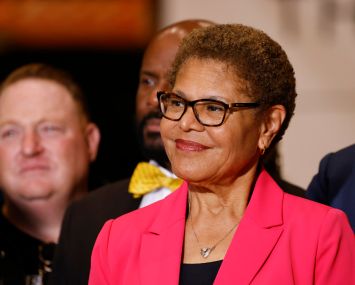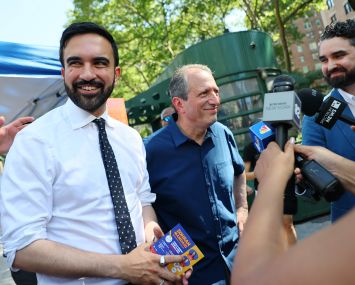Talking Affordability: Q&A With MidCity’s Michael Meers
Michael Meers on MidCity’s current projects, its commitment to affordable housing and its investment in social impact programs throughout the D.C. community.
By Keith Loria February 4, 2020 1:43 pm
reprints
Bethesda-based MidCity, a family-owned and operated developer, has a 50-plus year history of development and management of multifamily housing in Washington, D.C. Providing high-quality affordable housing has been central to MidCity’s mission since its founding in 1965.
The firm was founded by Eugene Ford, Sr., who constructed more than 15,000 affordable housing units throughout his career, Michael Meers, MidCity’s executive vice president, told Commercial Observer. The firm invests more than $1.5 million annually to provide supportive services within its affordable housing communities in the D.C. region.
“At this stage of our company’s growth, we are redeveloping aging assets into state-of-the-art mixed-income communities,” Meers said. “However, our commitment to developing and managing affordable housing remains an integral part of our company’s mission.”
CO recently spoke with Meers about MidCity’s current projects, its commitment to affordable housing and its investment in social impact programs throughout the D.C. community.
Commercial Observer: Characterize your current portfolio. What does it consist of?
Michael Meers: We are currently in the process of redeveloping several properties—all of which include an affordable housing component. Our largest project is the redevelopment of the Brookland Manor Apartments and Brentwood Village Shopping Center sites into a single mixed-income community called RIA (so named for Rhode Island Avenue in Northeast D.C.). We have owned the property for more than 40 years and are planning to build nearly 1,800 units on the site, including apartments, townhouses, and senior living, as well as a town center with retail, dining, and public-green spaces.
Integral to this plan is our commitment to develop a substantial number of affordable units. We have voluntarily agreed to retain the 373 units of Section 8 housing currently at the property, a preservation of assisted housing that is unmatched and unprecedented in the D.C. market.
Adjacent to RIA is 1400 Montana Ave, NE, which is in the pre-development phase. Projected for completion by the summer of 2021, 1400 Montana Ave will be a 108-unit multifamily building with nine affordable housing units at 60 percent AMI. This project will likely be one of the first opportunity zone developments to deliver in D.C.
A third development I’d point out is 1200 5th Street, NW, in the popular Shaw neighborhood of Washington, D.C. We are planning a 360-unit mixed-income building with a high degree of amenities, including a rooftop pool and two interior courtyards, all within two blocks of a Metro stop. That project is expected to deliver in 2023.
What is MidCity’s philosophy when it comes to affordable housing?
MidCity and the Ford family have a long history and demonstrated commitment to addressing housing insecurity and poverty by developing and responsibly managing service-enriched affordable housing communities. Today, our team is deeply philanthropically committed to affordable housing organizations and supportive services that help residents and communities thrive. Our team members serve on numerous boards and industry task forces to assist in the development and preservation of affordable housing and improve the quality of life for community residents.
Our active development projects all contain affordable housing components and, in most cases, significantly exceed the number of affordable units required by law. A good example of this is RIA, where more than 22 percent of the project is affordable housing, although D.C. only requires 10 percent. In many of our properties, we voluntarily provide resident services consisting of supports like food supplementation, tutoring, job readiness training, financial literacy services, and more.
Why is this strategy such an important one for you?
In the simplest terms, because we believe it’s the right thing to do. We believe people deserve safe, modern, affordable housing that is close to transit, job opportunities, and their families. We are deeply experienced in the development and management of affordable housing, and know that when an asset is properly managed, we can take care of our residents and deliver long-term value to our partners.
How has D.C. evolved in recent years in relation to affordable housing investment?
Over the past few years, we’ve witnessed a shift away from simply building housing units to a focus on creating affordable and mixed income development projects with specific set-asides. There is a strong preference now for mixed-income, mixed-use projects, where housing, retail, and accessibility are centralized. In tandem with these development shifts is an economic evolution – moving toward mixed-income housing that provides residents with more opportunities for economic mobility and the ability to live closer to work.
How would you characterize D.C.’s affordable housing shortage today?
D.C. consistently ranks as one of the most expensive places to live—so affordable housing remains a key point of discussion for policymakers, developers and the broader community in the region. A recent Metropolitan Council of Governments report found that due to strong economic growth, the D.C. metropolitan region may experience a shortage of 75,000 housing units in the next 10 years. Fortunately, many D.C. government and industry leaders are working hard to address the crisis.
Last year, D.C. Mayor Muriel Bower demonstrated exceptional leadership and set an audacious goal of building 36,000 new homes—including 12,000 affordable units—by 2025. There’s a lot of work to be done to meet this goal, however, and addressing density restrictions and PUD appeals by outside groups who bog down projects will be key to providing more affordable housing across the board.
The company invests heavily in social impact programs in the community. Can you please provide a couple of examples of this?
We have for decades supported many nonprofits in the area, including The Academy of Hope (AOH) and D.C. Habitat for Humanity. Both organizations are doing incredible work across the city and we are pleased to partner with them.
At the property level, we are investing in a variety of resident services focused on education, employment, health and wellness, and resident engagement across our portfolio. For example, at our Brookland Manor property, we provide tutoring for children; coding classes; employment readiness training such as GED/ABE enrollment; financial literacy and technology training; and a variety of social events.
We believe that these programs are essential for our residents and improve the overall performance of the communities that we invest in.
What has your partnership with the Academy of Hope Public Charter School accomplished?
MidCity and AOH have been partners for more than two decades to enable adult learners across the city, including those at MidCity-owned properties, to restart their education and advance their job readiness. Throughout our partnership with AOH, we have donated $1 million and helped with the opening of a campus in Northeast Washington, D.C.
Over the past five years, 70 Brookland Manor residents have attended AOH, and MidCity has supported and sponsored various projects on behalf of AOH.
Just this past year, we sponsored a research project designed to identify ways in which AOH can increase enrollment and reduce educational barriers for low-income adult learners. It is our hope that this data will allow AOH to tailor its recruiting and retention strategies to allow more students to enter and finish the program.
We are also proud to be sponsoring AOH’s 35th anniversary gala, which will take place in April 2020.
Talk about ART PARK @ RIA and what this does. Why is this an important program?
ART PARK @ RIA is a partnership between MidCity, Nonstop Art, DC Public Library and The Phillips Collection where we have programmed a vacant parcel (part of the future RIA development) with free arts-driven programming for the community. Our free, all-ages workshops include mural painting, screen printing, and mixed media collaging.
Where do you see MidCity in the years ahead?
Our region is facing a significant housing shortage and I believe MidCity will continue to play a key role in helping bring more housing, including affordable and workforce housing, to communities across the city. This is what we have done since our founding 55 years ago. It is our business, but more importantly this is where we live and how we want to do our part to meet the needs of a growing city facing a myriad of challenges.
What has been the secret to your success?
Sustaining relationships and doing the small things right over time has allowed us to persevere through many market cycles and other challenging times in our city.


